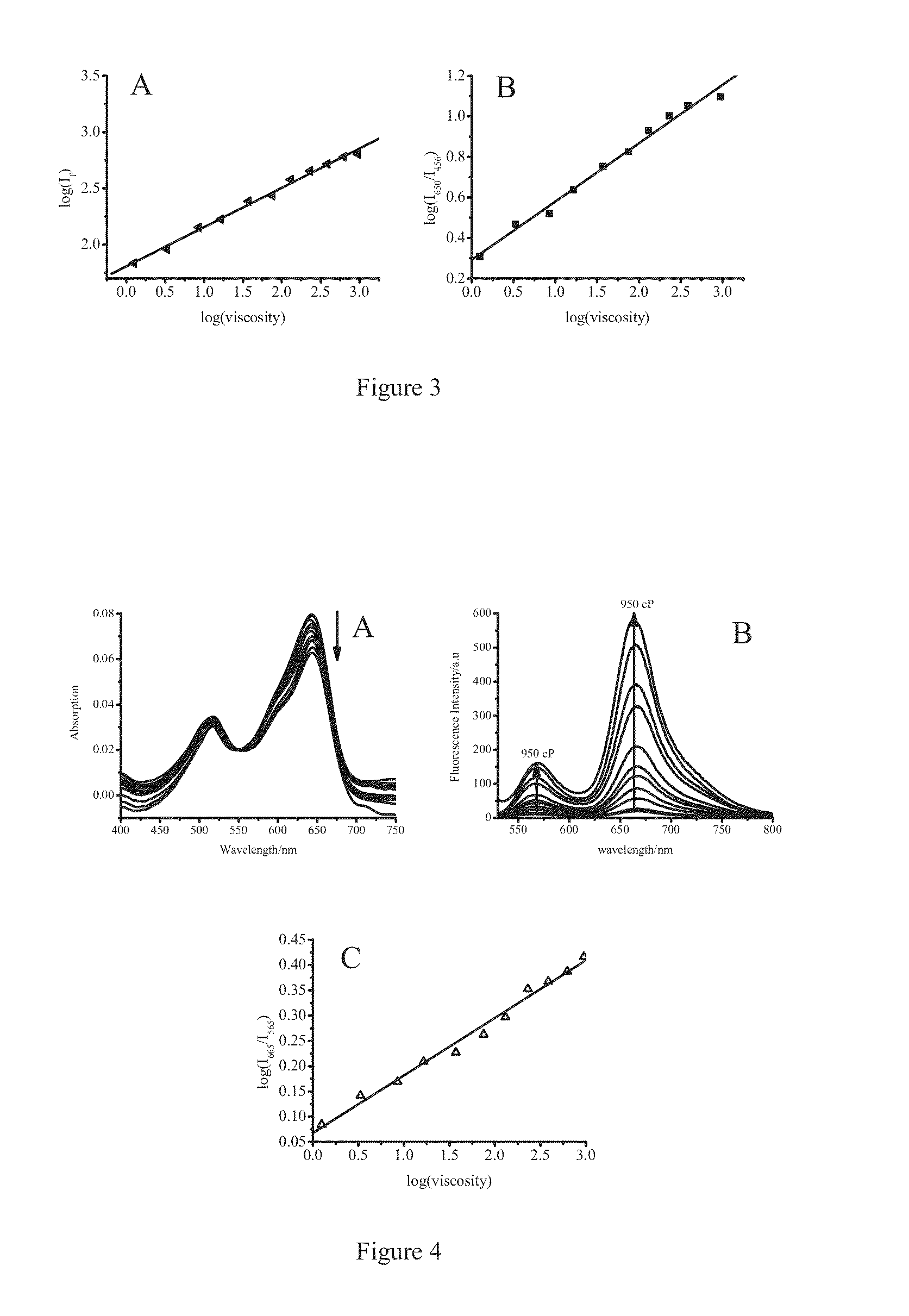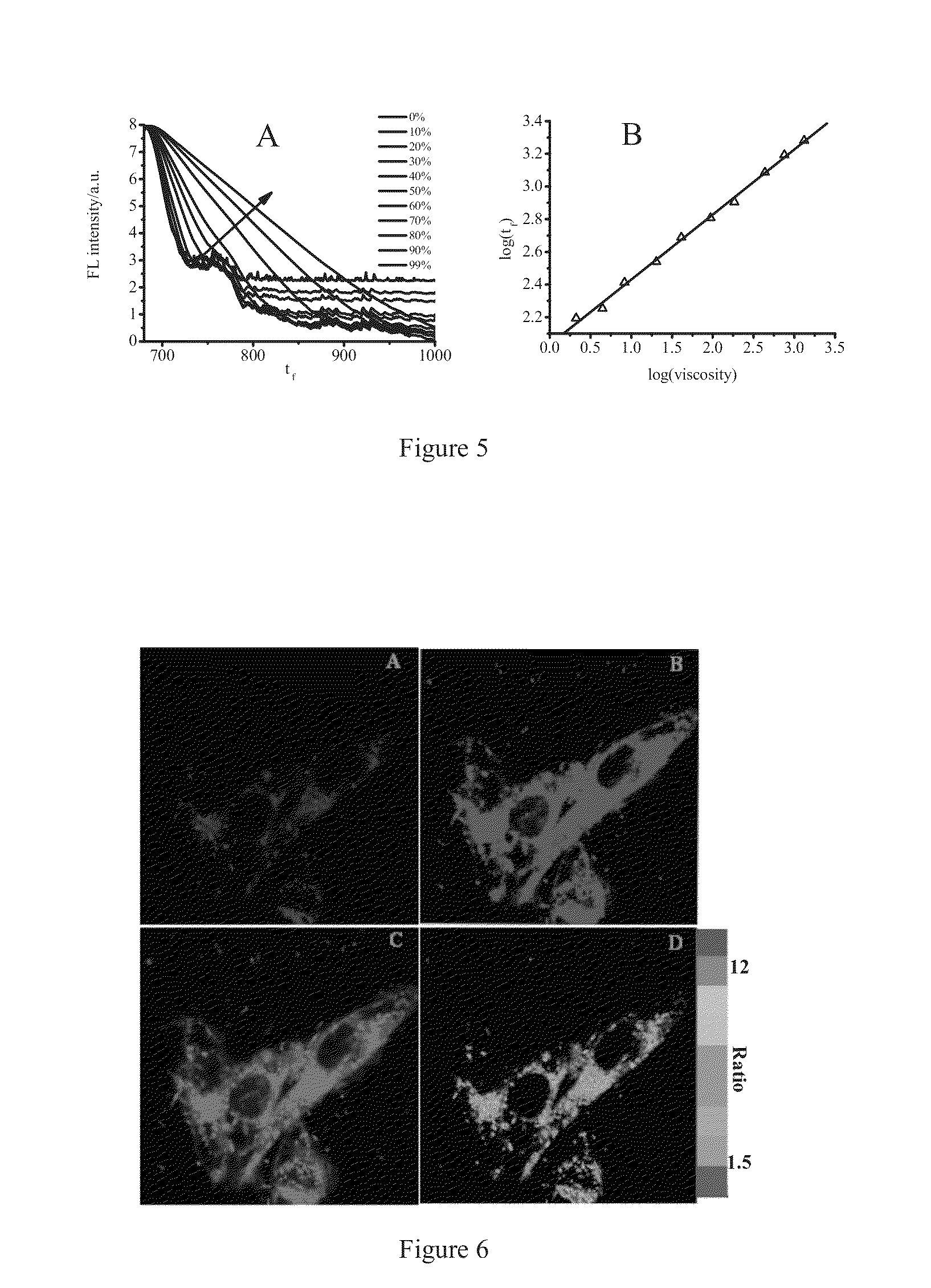Pentamethine cyanine fluorescent dyes, preparation methods and uses thereof
a fluorescent dye and pentamethine technology, applied in the field of pentamethine cyanine fluorescent dyes, can solve the problems of not being able to use both detection methods and devices, unable to guarantee the usability of viscometers, and unable to detect fluid viscosity of macroscopically large volume, so as to avoid the influence of solvent polarity, and sensitive to environmental viscosity
- Summary
- Abstract
- Description
- Claims
- Application Information
AI Technical Summary
Benefits of technology
Problems solved by technology
Method used
Image
Examples
example 1
[0085]Synthesis of 4 and 7
[0086]Synthetic schemes of 4 and 7 were shown in FIG. 11.
(1) Synthesis of 2,3,3-trimethyl-3H-indoline (the compound 1) according to Fisher indole synthesis method
[0087]Phenylhydrazine 54 g (0.5 mol) was added into a 250 mL two-neck flask, and 3-methyl-2-butanone 43 g (0.5 mol) was added dropwise under stirring, the mixture was heated to 70-80° C. and reacted for 4 h, then the water layer was separated, and the separated water layer was extracted with diethyl ether. The organic phase was combined, dried with anhydrous MgSO4 and filtered, and then solvent was removed under reduced pressure to obtain crude hydrazone 70 g (yield: 80%).
[0088]The obtained crude hydrazone 70 g (0.4 mol) was added into 150 mL glacial acetic acid, the obtained mixture was reacted at 90° C. oil bath for 3 h and then cooled down to room temperature. The water layer of the reaction solution was neutralized to neutral with saturated Na2CO3 aqueous solution, the water phase and the organ...
example 2
[0102]Analysis of Spectral Properties of 4 and 7
[0103]Firstly, stock solutions of 4 and 7 in DMSO were prepared respectively. Then sample solutions of 1 μM were prepared by diluting the mother liquors with corresponding chromatography grade solvent. UV absorption and fluorescence emission spectra of the sample solutions in different solvents were measured at room temperature, the results were shown in FIGS. 1A and 1B, respectively. In the meanwhile, spectral properties of 4, 7 and ethyl-Cy5 were also investigated; the results were shown in table 1.
[0104]From the results, it can be seen that, compared with the traditional pentamethine cyanine fluorescent dye (ethyl-Cy5), both 4 and 7 as fluorescence probe have two groups of absorption peaks and emission peaks (400 and 610 nm, 456 and 650 nm for 4; 510 and 655 nm, 565 and 668 nm for 7). In ethanol, fluorescence quantum yields of 4, 7 and ethyl-Cy5 are 0.0108, 0.0048 and 0.27, respectively, fluorescence quantum yields of the former two...
example 3
[0106]Viscosity Experiments of Compounds 4 and 7
[0107]Firstly, DMSO solutions of 4 and 7 having a concentration of 1.0×10−3 M were prepared, respectively. The stock solution of 10 L was added into 10 mL glycerol-ethanol mixture, and ultrasonicated to remove bubbles. The solution stayed for 1 hour, and then absorption and emission spectra therefore were measured by using UV-visible spectrophotometer and fluorescence spectrophotometer, and fluorescence lifetime of solution with different viscosity was detected as well. UV-visible spectrophotometer, model: Hp8453; fluorescence spectrophotometer model: FP-6500; Fluorescence lifetime equipment: Horiba Jobin Yvon Fluoromax-4-p.
[0108]Glycerol-ethanol mixture was a mixture of glycerol and ethanol, Vglycerol: Vethanol were 1:9, 2:8, 3:7, 4:6, 5:5, 6:4, 7:3, 8:2 and 9:1.
[0109]After the solution stayed for a period of time at some temperature for bubbles disappearing, UV-visible absorption spectrum (as shown in FIG. 2A) and fluorescence emissi...
PUM
| Property | Measurement | Unit |
|---|---|---|
| temperature | aaaaa | aaaaa |
| temperature | aaaaa | aaaaa |
| molar ratio | aaaaa | aaaaa |
Abstract
Description
Claims
Application Information
 Login to View More
Login to View More - R&D
- Intellectual Property
- Life Sciences
- Materials
- Tech Scout
- Unparalleled Data Quality
- Higher Quality Content
- 60% Fewer Hallucinations
Browse by: Latest US Patents, China's latest patents, Technical Efficacy Thesaurus, Application Domain, Technology Topic, Popular Technical Reports.
© 2025 PatSnap. All rights reserved.Legal|Privacy policy|Modern Slavery Act Transparency Statement|Sitemap|About US| Contact US: help@patsnap.com



